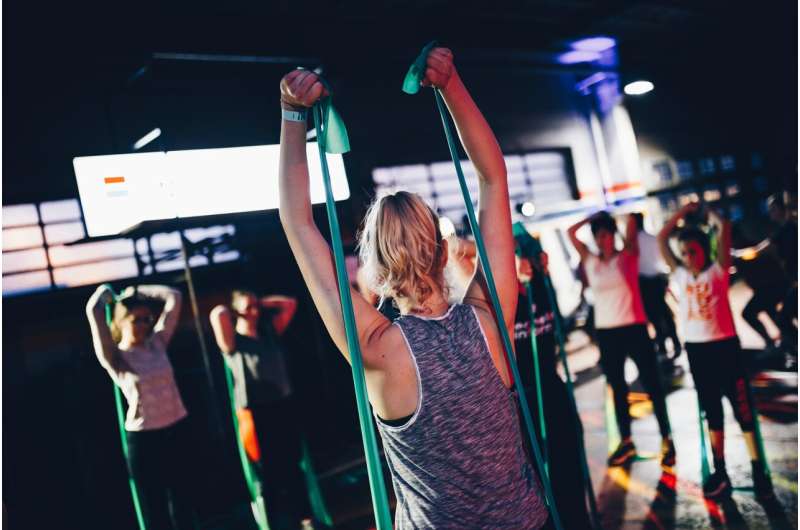This article has been reviewed according to Science X's editorial process and policies. Editors have highlighted the following attributes while ensuring the content's credibility:
fact-checked
trusted source
proofread
More neighborhood fitness spaces linked to higher physical activity levels after stroke

Stroke survivors were more likely to remain physically active or even exercise more after their stroke if they lived in neighborhoods with easy access to recreational centers and gyms, according to a preliminary study to be presented at the American Stroke Association's International Stroke Conference 2024. The meeting will be held in Phoenix, Feb. 7-9.
"We know that stroke survivors need to be physically active as part of their recovery. Our findings suggest that it's important to have a conversation with stroke patients about physical activity resources available in their area so they are able to continue their recovery after hospital discharge," said lead study author Jeffrey Wing, Ph.D., M.P.H., an assistant professor of epidemiology at The Ohio State University in Columbus, Ohio. "If their neighborhood does not offer fitness resources, neurologists should consider discharging the patient to a rehabilitation facility where they can participate in physical activities."
In this study, researchers examined the potential link between available fitness/exercise centers, pools and gyms, and physical activity among 333 people living in New York City who had experienced a mild stroke. The data was geocoded, assigned to the U.S. census tracts, and merged with data from the National Neighborhood Data Archive (which collects information about the number of physical activity resources at the census tract level).
Geocoding is the process of transforming a description of a location—such as an address or a name of a place—to a location on the Earth's surface. Researchers then examined the association between the number of fitness and recreational centers, such as pools, gyms and skating rinks per square mile, and the self-reported change in physical activity levels—more active, about the same or less active—one year after stroke.
The analysis found:
- About 17% of participants reported being more physically active one year after stroke, and 48% reported having about the same level of physical activity as before the stroke.
- The odds of being more active were 57% higher among participants who lived in areas with more recreational and fitness resources (about 58 fitness resources) compared to people living in neighborhoods with fewer or no fitness resources, after controlling for age, gender, race, ethnicity, education, health insurance and body mass index.
- Similarly, the odds of reporting the same level of physical activity one year after stroke were 47% higher in participants who lived in areas with more recreational centers and fitness resources compared to those who lived in areas with fewer or no resources available.
Previous research has shown that even moderate physical activity is beneficial for stroke recovery and can include walking, Wing said. "However, it's important to recognize the availability or limited availability of exercise resources in a person's immediate neighborhood and to be able to feel safe while participating in exercise activities."
Previous research has found that the characteristics of the built environment of a neighborhood, such as access to healthy food or recreational spaces promoting physical activity, were also linked to lower incidence of stroke, Wing noted.
"The takeaway from this analysis is that it's not that people should move to a location where there are more resources to engage in physical activity, but to urge people to find ways to be active in their own neighborhood," said study co-author Julie Strominger, a Ph.D. student of epidemiology at The Ohio State University. "It's the action that will lead to better outcomes, so just the action of being physically active is what really matters."
"This study is consistent with prior research on the importance of physical activity for optimal health. The new aspect is the focus on stroke survivors," said American Stroke Association volunteer expert and EPI and Stroke Council member Daniel T. Lackland, Dr.P.H., FAHA, professor of epidemiology and director of the Division of Translational Neurosciences and Population Studies in the department of neurology at the Medical University of South Carolina in Charleston. "It's important for health care professionals to discuss maintaining physical activity with stroke survivors: find out if they know of a safe place to exercise, and if they do not, have that information readily available." Lackland was not involved in the study.
Study details and background:
- The analysis included 333 adults hospitalized for mild stroke and enrolled in the Discharge Educational Strategies for Reduction of Vascular Events (DESERVE) study.
- The DESERVE study was a randomized clinical trial of 546 stroke survivors and conducted in New York City from 2012-2016.
- Participants were 52% women, with an average age of 65 years; they self-identified as 35% Hispanic adults, 31% Black adults, 28% white adults and 6% as "other" race.
The main limitations of the study, according to the authors, are that the findings may not be generalizable to non-urban neighborhoods in the U.S. In addition, the data was extracted from a clinical trial that included only stroke survivors who had a mild stroke, therefore, this association may not hold true for survivors of severe stroke. Also, while people in certain neighborhoods reported more physical activity, that does not necessarily mean that they used the fitness and recreational resources in their neighborhood.
More information: Abstract poster TMP26: www.abstractsonline.com/pp8/#! … 42/presentation/2601




















